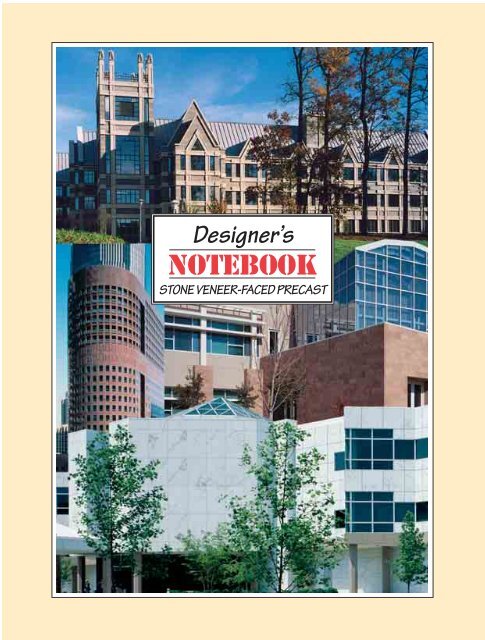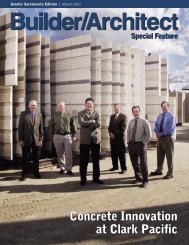Designers Notebook - Stone Veneer-Faced Precast part 1
Designers Notebook - Stone Veneer-Faced Precast part 1
Designers Notebook - Stone Veneer-Faced Precast part 1
- No tags were found...
Create successful ePaper yourself
Turn your PDF publications into a flip-book with our unique Google optimized e-Paper software.
Designer’sNOTEBOOKSTONE VENEER-FACED PRECAST
German limestone is anchoredto precast panels on the TerrySanford Institute of PublicPolicy at Duke University inDurham, N.C. (Architect:Architectural ResourcesCambridge Inc.)The production of stone veneer panels requires adequate lead time in order to avoidconstruction delays. Therefore, it is important that approvals for shop drawings are obtainedexpeditiously. Furthermore, it is recommended that the designer allow the submission of shopdrawings in predetermined stages so manufacturing can begin as soon as possible and ensurethere is a steady and timely flow of approved information to allow uninterrupted fabrication.The precast concrete producer must provide the stone quantity and sequence requirementsto meet the erection sequences. The precaster and stone fabricator should coordinatepackaging requirements to minimize handling and breakage. Extra stone (approximately 2 to 5percent) should be supplied to allow immediate replacement of damaged stone pieces,<strong>part</strong>icularly if the stone is not supplied from a domestic source.Because of the difference in material properties between natural stone and concrete,veneered panels are more susceptible to bowing than all-concrete units. However, panelmanufacturers have developed design and production procedures to minimize bowing.The panel manufacturer and designer should consider the following in design and productionin order to minimize or eliminate panel bowing:1. The temperature differential (exterior to interior).2. Coefficients of expansion of the materials.3. Ratio of cross-sectional areas of the materials and their moduli of elasticity.4. Amount, location and type of reinforcement in the concrete panel.5. The use of prestressing.6. Type and location of connections to the structure.7. Rigidity of connection between stone veneer and concrete backup (too rigidmay cause problems).8. Shrinkage of the concrete.Minimum thickness of backup concrete on flat panels that will control bowing or warping isusually 5 to 6 inches, but 4 inches has been used where the panel is small, or it has adequaterigidity obtained through panels shape or thickness of natural stone. See Fig. 2 for moldconsiderations. Cover depth of reinforcement must be a minimum of 3/4 inch at the veneersurface. Non-corrosive spacers such as plastic should maintain this cover.<strong>Stone</strong> StrengthThe strength of natural stone depends on several factors: the size, rift and cleavage ofcrystals, the degree of cohesion, the interlocking geometry of crystals, the nature of naturalcementing materials present and the type of crystal. The stone’s properties will vary with thelocality from which it is quarried. Therefore, it is important that current testing is performedfor stone quarried for a specific project.Sedimentary and metamorphic rocks, such as limestone and marble, will exhibit differentstrengths when measured parallel and perpendicular to their original bedding planes. Igneous41
ocks, such as granite, mayTypical Flat Moldor may not exhibit relativelyuniform strength characteristicson the variousplanes. In addition, theFlat Mold For Natural <strong>Stone</strong>Little or no additional costsurface finish, freezing andthawing, and large temperaturefluctuations will affect Clearances built in formface for natural stonethe strength and in turn handling deviceReturn Mold For Natural <strong>Stone</strong>influence the anchorageAdditional mold<strong>Stone</strong> must be held in placesystem.cost for backformingandwith clamps or disposable(galv./St. Stl.) threadedInformation on thedaily labor tofasteners (at joints) that areattach stoneremoved after each pour,durability of the specifiedto return wallleaving a threaded wingassembly embedded in thestone should be obtainedconcrete panelthrough current testing inconjunction with observationsof existing installa-Fig. 2 Moldstions of that <strong>part</strong>icular stone. This information should include such factors as tendency towarp, reaction to weathering forces, resistance to chemical pollutants, resistance to chemicalreaction from adjacent materials and reduction in strength from the effects of weathering orwetting and drying.Prior to awarding the precast concrete contract, tests should be performed to determinethe physical properties of the stone being considered. The testing should be done on stonewith the same finish and thickness to be used on the structure. Flexural tests (ASTM C880)should be used to evaluate the physical properties and obtain design values. Absorptiontesting (ASTM C97) helps evaluate freeze-thaw durability. These properties, along withproperties of the anchor system, should be used to ensure adequate strength of the panelto resist loads during handling, transportation, erection and in-service conditions.42<strong>Stone</strong> Sizes<strong>Stone</strong> veneers used for precast facing are usually thinner than those used for conventionallyset stone, with the maximum size generally determined by the stone strength. Table 1summarizes typical dimensions. <strong>Veneer</strong>s thinner than those listed can result in anchors beingreflected on the exposed surface, excessive breakage or permeability problems.The length and width of veneer materials should be sized to a tolerance of +0 – 1/8 inch, sincea plus tolerance can present problems on precast concrete panels. This tolerance becomesimportant when trying to line up the false joints on one panel with those on the panel above orbelow, <strong>part</strong>icularly when there are a large number of pieces of stone on each panel. Tolerance
allowance for out-of-square is± 1/16-inch difference in length ofthe two diagonal measurements.Flatness tolerances forfinished surfaces depend on thetype of finish. For example, thegranite industry’s flatnessTable 1 Dimensional parameters of various stone materialsMinimumrecommendedthickness (in.)Lengthrange (ft.)* Surface voids filled front and backWidthrange (ft.)Maximumarea (ft 2 )Marble 1.25 3-5 2-5 25Travertine* 1.25 2-5 1-4 16Granite 1.25 3-7 1-5 30Limestone 2.00 4-5 2-4 15tolerances vary from 3/64 inch for a polished surface to 3/16 inch for flame (thermal) finishwhen measured with a 4-foot straight edge. Thickness variations are less important, sinceconcrete will provide a uniform back face except at corner butt joints. In such cases, thefinished edges should be within ± 1/16 inch of the specified thickness. However, large thicknessvariations may lead to the stone being encased with concrete and thus restrict relativemovement of the materials. The aesthetic problems that occur with tolerances concern thevariation from a flat surface on an exposed face and stone pieces being out of square.Anchorage of<strong>Stone</strong> FacingThe stone fabricator or precaster appear to have the dominant responsibility for conductingthe anchor tests, with the architect or engineer of record occasionally determining the type ofanchorage. However, it is preferable for the architect to determine anchor spacing so thatcommon information can be supplied to all bidders (refer to ASTM C1242). Contractdocuments should define clearly who drills the anchor holes in the stone; type, number andlocation of anchors; and who supplies the anchors. In most cases, the stone fabricator drillsthe anchor holes in the stone using a diamond-core bit with a non-pneumatic tool.It is recommended that the precaster detail all precast units to the point where the fabricatorof the veneer is able to incorporate details, sizes and anchor holes for the individualstone pieces.It also is recommended that there be no bonding between stone veneer and concrete backupin order to minimize bowing, cracking and staining of the veneer. Flexible mechanical anchorsshould be used to secure the veneer.Two methods may be used to prevent bond between the veneer and concrete to allow forindependent movement: a 6-mil polyethylene sheet or a closed-cell, 1/8- to 1/4-inchFive Fremont Center in SanFrancisco is clad with 1 1/4-and2-inch-thick travertine-facedprecast concrete panels.(Architect: Skidmore,Owings & Merrill)polyethylene foam pad. Using a compressible bondbreaker is preferred because it allowsmovement of stones with uneven surfaces, either of individual pieces or between stone pieceson a panel.Preformed anchors, 1/8- to 5/8-inch in diameter, fabricated from Type 304 stainless steel,are supplied by the stone fabricator or, in some cases, by the precaster depending on thecontract document requirements. The number and location of anchors should be determinedby a minimum of five shear and tension tests conducted on a single anchor embedded in a43
stone/precast concrete test sample using ASTM E488 or ASTM C1354 and the anticipatedapplied loads, both normal and transverse to the panel. Care should be taken in grasping theanchor.Design of anchorage and size of the stone should be based on specific test values for the actual2"4"2"stone to be installed. Testsamples for anchor testsDepth of concretevaries accordingto designd b= 5/32" min.S.S. Anchor30° to 45°should be a typical panelsection of about 1 square footand approximate as closely ast varies1 1/4" min. PreferredHole 1/16" > d b6" to 9"To Edge of <strong>Stone</strong>BondBreakerFace of<strong>Stone</strong> <strong>Veneer</strong>Fig. 3 Typical anchor for marble veneer1/2 t3/4" min.possible actual panel anchoringconditions. A bondbreakershould be placed between stoneand concrete during samplemanufacture to eliminate anybond between veneer and concrete surface. Depending on the size of the project, it may be desirableto perform shear and tensile tests of the anchors at intervals during the fabrication period.Four anchors usually are used per stone piece, with a minimum of two recommended. Thenumber of anchors has varied from one per 1 1/2 square foot of stone to one per 6 square feet,with one per 2 to 3 square feet being the most common. Anchors should be 6 to 9 inchesfrom an edge with not more than 24 to 30 inches between anchors depending on the localbuilding code. The shear capacity of the spring clip (hairpin) anchors perpendicular to theanchor legs is greater than when they are parallel, and capacity depends on the strength ofthe stone. A typical marble veneer anchor detail with a toe-in spring clip (hairpin) anchor isshown in Fig. 3, while a typical granite veneer anchor detail is shown in Fig. 4. The toe-outanchor in granite may have as much as 50 percent more tensile capacity than a toe-inanchor, depending on the stone strength.Depth of anchor holes should be approximately half the thickness of the veneer (minimum depth of3/4 inch). Minimum concrete cover over the drilled hole should be 3/8 inch to avoid spalling duringdrilling and spotting from absorbedmoisture. The hole should be drilled at anangle of 30 to 45 degrees to the planeof the stone. Holes 1/16 inch larger thanDepth of concretevaries accordingto designS.S. Anchord b= 5/32"min.BondBreakerthe anchor are common, as excessivelooseness reduces holding power. Anchorholes should be within ± 3/16 inch of thespecified hole spacing, <strong>part</strong>icularly for1/2 t3/4" min.30° to 45°6" to 9"To Edge of <strong>Stone</strong>Hole1/16" > d bFace of<strong>Stone</strong> <strong>Veneer</strong>t varies1 1/4" min. Preferred44the spring clip anchors.Fig. 4 Typical anchor for granite veneer
d bStainless-steel dowels,smooth or threaded, may beS.S. Anchord b= 3/16 to 5/8installed to a depth of twothirdsDepth of concrete2 1/2" Min.of the stone thickness,varies accordingto designconcrete backup to develop the1/16" > d b be Epoxied<strong>Stone</strong> <strong>Veneer</strong>with a maximum depth of 22/3 t2" Max45° to 60°inches at 45- to 60-degreeangles to the plane of the stone. t (Varies)BondClose slotsBreaker2"with tapeThe minimum embedment in theHoleDowels May Face ofrequired bond length is shown inFig. 5 Typical cross anchor dowels for stone veneerFig. 5. Dowel size varies from 3/16 to 5/8 inch for most stones, except that it varies from 1/4to 5/8 inch for soft limestone and sandstone and depends on thickness and strength ofstone.Limestone traditionally has been bonded and anchored to the concrete, because it has thelowest coefficient of expansion. Limestone also has been used traditionally in thicknesses of3 to 5 inches, but it is now being used as thin as 1 3/4 inches. If limestone is to be bonded, usea moisture barrier/bonding agent on the backside of the stone to eliminate the possibility ofstaining the stone veneer with alkali salts in the concrete. When limestone is 2 inches orthinner, use a bondbreaker along with mechanical anchors. Dowels and spring-clip anchorscan be used to anchor limestone. Typical dowel details for limestone veneers are shown inFigs. 5 and 6. The dowels in Fig. 6 should be inserted at opposing angles to secure stonefacing to the backup concrete.Some flexibility should be introduced with all anchors by minimizing the anchor’s diameter,to allow for the inevitable relative movements that occur with temperature variations andconcrete shrinkage. Unaccommodated relative movements can result in excessive stressproblems and eventual failure at an anchor location. Depending on the size of the project,DeformedVariesBond BreakerS.S. Anchor d b= 3/16 to 5/8*consideration may be given toaccelerated cyclic temperature testsConcreteDowels maybe epoxiedVariesto determine the effects on thehole 1/16" > db3/4" min. in 2"stone 2" max.anchors.<strong>Stone</strong>in 5" stoneSome designers use two-<strong>part</strong>DeformedBond BreakerS.S. Anchor d b= 3/16 to 5/8*15°polyester or epoxy to fill the anchorFig. 6ConcreteVaries holes in order to eliminate intrusion ofTypical anchorsfor limestone veneer<strong>Stone</strong>2" to 5"water into the holes and to prevent thepossible dark, damp appearance of1" to 2"moisture on the exposed stone surface.30° to 45°* Use anchors at opposing anglesThe polyester or epoxy increases the45
Fig. 7:This is an example of acompressible sleeve used toreduce stone anchor rigiditywhen the anchors are epoxiedin the stone.shear capacity and rigidity of theanchors. The rigidity may be <strong>part</strong>iallyovercome by using 1/2-inch-longcompressible (60 durometer) rubber orelastomeric grommets or sleeves on theanchor at the back surface of the stone,as seen in Fig. 7.Differential thermal expansion of thestone and unfilled epoxy may cause<strong>Precast</strong> concrete panels are integrally cast with Arizona Redsandstone on the Roseville Telphone Company in Roseville, Calif. cracking of the stone veneer. The(Architect: Williams & Paddon Architects & Planners/Inc.)coefficient of expansion of epoxy and stoneshould closely match. It may be more desirable to fill the anchor hole with a low modulus polyurethanesealant. The overall effect of either epoxy or sealant materials on the behavior of the entire veneer shouldbe evaluated prior to their use. At best, the long-term service of epoxy is questionable, so any increase inshear value should not be used in calculating long-term anchor capacity.The stone trade associations and the suppliers of different kinds of building stones recommend safetyfactors. Because of the expected variation in the physical properties of natural stones and the effectsof weathering, recommended safety factors are larger than those used for manufactured buildingmaterials, such as steel and concrete. The minimum recommended safety factor, based on the averageof the test results, is 4 for anchorage components. If the range of test values exceeds the average bymore than ±20 percent, then the safety factor should be applied to the lower bound value. (See Appendixto ASTM C1242 for a discussion on safety factors.)Finite-element analysis is a useful technique forevaluating stress in a veneer panel system. Thisnecessitates testing to determine the spring constantvalues for the panel’s material components to model theassembly. <strong>Stone</strong> veneer should be tested in flexure, (ASTMC1352). The section properties and modulus of elasticityalso should be determined. Granite rift (bedding) planes,Architectural precast panels for the newdirection and grain size influence modulus of elasticity. Shear wing of the Joslyn Art Museum, Omaha,Neb., are clad in Georgia marble to matchand tensile tests are required for the anchors. The springthe original stone building constructed inconstant of a compressible bondbreaker should be determined. 1931. Labor and material cost werereduced using this system compared toFor insulation, compressive-spring and shear-spring constants traditional stone cladding systems.(Architect: Henningson, Durham &should be determined if no bondbreaker is used.Richardson Inc.)COMING NEXT ISSUE: More on stone veneer-faced precast,including the unique perspective of a practicing architect.46




